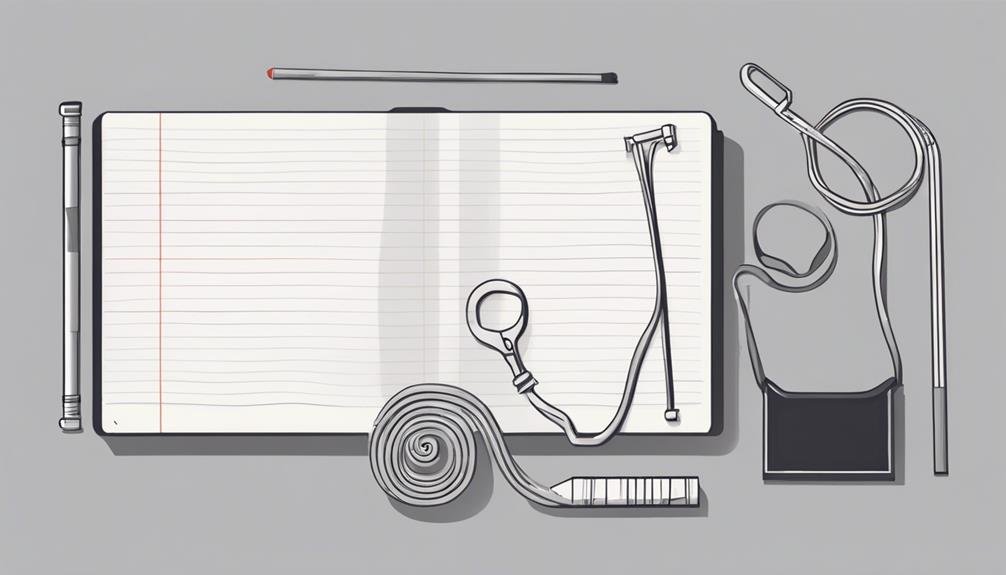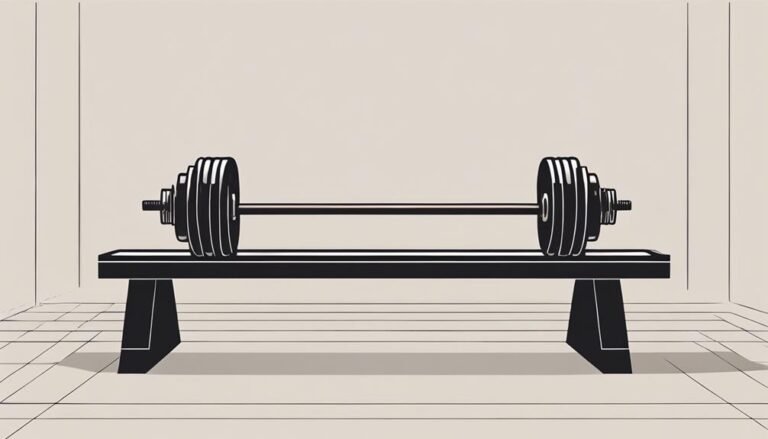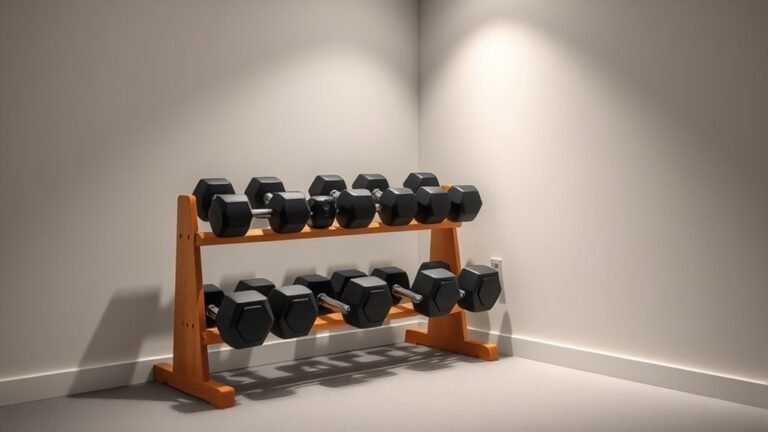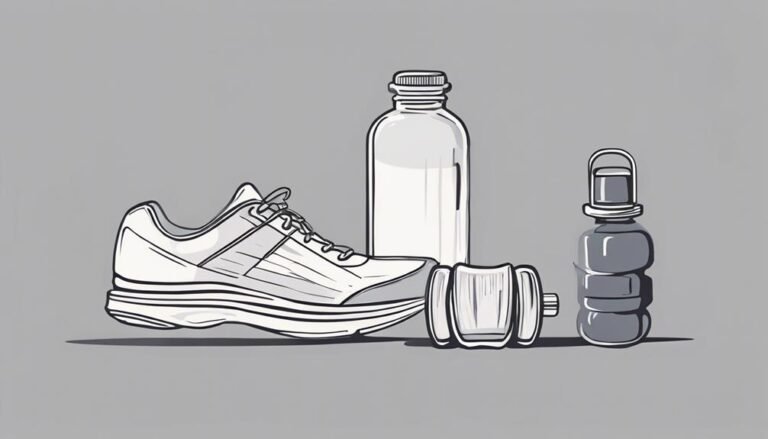Maintaining Muscle Mass: Essential Tips for Men 40
To maintain your muscle mass after 40, focus on strength training and consistency. Aim for three to four workouts weekly, emphasizing compound exercises like squats, deadlifts, and bench presses. Prioritize a balanced diet rich in protein, aiming for 1.2 to 2.0 grams per kilogram of body weight, and include healthy fats and plenty of fruits and vegetables. Don't overlook recovery; make certain you get 7-9 hours of quality sleep, stay hydrated, and incorporate active recovery. Tracking your workouts and nutrition helps you adjust and stay on track for peak results. There's more to discover to enhance your journey.
Key Takeaways
- Engage in strength training at least three to four times weekly to preserve muscle mass and enhance overall fitness.
- Focus on compound movements like squats, deadlifts, and bench presses for effective muscle retention and growth.
- Maintain a balanced diet rich in protein, aiming for 1.2 to 2.0 grams per kg of body weight to support muscle maintenance.
- Prioritize recovery through quality sleep, hydration, and active recovery to maximize the benefits of your workouts.
Importance of Strength Training
Strength training is essential for men over 40, as it helps maintain muscle mass and boosts overall health.
As you age, your body naturally starts to lose muscle, which can lead to decreased strength and mobility. By incorporating strength training into your routine, you counteract this decline, enhancing your physical performance and daily activities.
It also plays a vital role in increasing your metabolism, which helps manage weight and reduces the risk of chronic diseases.
Beyond physical benefits, strength training can improve your mental health by reducing stress and boosting self-confidence.
Committing to a regular strength training regimen not only preserves your muscle mass but also supports your overall well-being, keeping you active and vibrant as you age.
Key Exercises for Muscle Retention

To effectively maintain muscle mass, incorporating specific exercises into your routine can make a significant difference in your overall strength and health. Focus on compound movements that engage multiple muscle groups, as these will maximize your muscle retention.
Here are three key exercises to include:
- Squats: These work your quads, hamstrings, and glutes, providing a solid foundation for lower body strength.
- Deadlifts: This full-body exercise targets your back, glutes, and hamstrings, promoting overall muscle growth.
- Bench Press: A staple for upper body strength, the bench press effectively targets your chest, shoulders, and triceps.
Integrating these exercises into your weekly routine will help you preserve muscle mass and enhance your fitness levels as you age.
Nutrition for Muscle Maintenance
Eating a balanced diet rich in protein and essential nutrients is essential for maintaining muscle mass as you age.
Focus on incorporating lean meats, fish, eggs, legumes, and dairy into your meals. Aim for a protein intake of around 1.2 to 2.0 grams per kilogram of body weight daily.
Don't forget healthy fats from sources like avocados, nuts, and olive oil, as they support hormone production.
Include a variety of fruits and vegetables to provide antioxidants and micronutrients that aid muscle function.
Stay hydrated, too; water plays a significant role in muscle recovery and performance.
Recovery Strategies for Older Adults

As you focus on nutrition for muscle maintenance, don't overlook the importance of effective recovery strategies to support your body's ability to repair and grow stronger.
Prioritizing recovery helps you maximize your workouts and maintain muscle mass as you age. Here are three key strategies to reflect on:
- Sleep Well: Aim for 7-9 hours of quality sleep each night. Sleep is essential for muscle recovery and hormone regulation.
- Hydration: Stay hydrated to facilitate nutrient transport and muscle function. Aim for at least 8-10 cups of water daily, adjusting for activity levels.
- Active Recovery: Incorporate light activities like walking or yoga on rest days to promote blood flow and reduce stiffness.
Consistency in Workout Routines
Consistency in your workout routine is essential for preserving muscle mass, especially as you age. Sticking to a regular schedule not only helps you build strength but also prevents muscle loss. Aim for at least three to four workouts each week, focusing on both resistance training and cardiovascular exercises.
Here's a quick reminder of how you can structure your week:
| Day | Activity |
|---|---|
| Monday | Upper Body Workout |
| Wednesday | Lower Body Workout |
| Friday | Full Body Workout |
Tracking Progress Over Time

Tracking your progress over time is vital for understanding how your body responds to workouts and making necessary adjustments. By keeping tabs on your performance, you can identify what's working and what isn't.
Here are three effective ways to track your progress:
- Log Your Workouts: Write down the exercises, weights, and reps each session. This helps you see improvements over time.
- Take Measurements: Regularly measure your body parts—like arms, chest, and waist—to monitor muscle gain and fat loss.
- Track Your Nutrition: Keep a food diary to guarantee you're fueling your body correctly, which plays an important role in maintaining muscle mass.
Questions
How Often Should I Change My Workout Routine?
You should change your workout routine every 4 to 6 weeks. This keeps your body challenged, prevents plateaus, and maintains your motivation. Listen to your body, and adjust based on your progress and goals.
Can Supplements Help Maintain Muscle Mass?
Supplements can indeed help maintain muscle mass, especially if you're lacking essential nutrients. They provide added support to your diet, but they shouldn't replace whole foods. Balance your intake for the best results.
Is Cardio Detrimental to Muscle Retention?
Think of cardio as a double-edged sword; it can enhance heart health but may hinder muscle retention if overdone. Balance your workouts, and you'll keep your muscles while enjoying the benefits of cardio.
What Role Does Hydration Play in Muscle Maintenance?
Hydration's essential for muscle maintenance. It supports nutrient transport and helps prevent fatigue during workouts. When you're well-hydrated, your muscles perform better, recover faster, and reduce the risk of cramps and injuries. Stay hydrated!
Are There Specific Exercises for Preventing Injury While Retaining Muscle?
Think of your body as a finely tuned instrument. To prevent injury while retaining muscle, focus on low-impact exercises like swimming, cycling, and yoga, integrating strength training with proper form to harmonize movement and stability.
Conclusion
In your journey to maintain muscle mass after 40, think of your body as a classic car.
Just like a vintage vehicle needs regular maintenance to stay in peak condition, your muscles require consistent strength training, proper nutrition, and recovery.
By dedicating time to these essential practices, you'll not only preserve your strength but also enhance your overall well-being.
Remember, it's never too late to rev up your engine and keep cruising toward your fitness goals!







